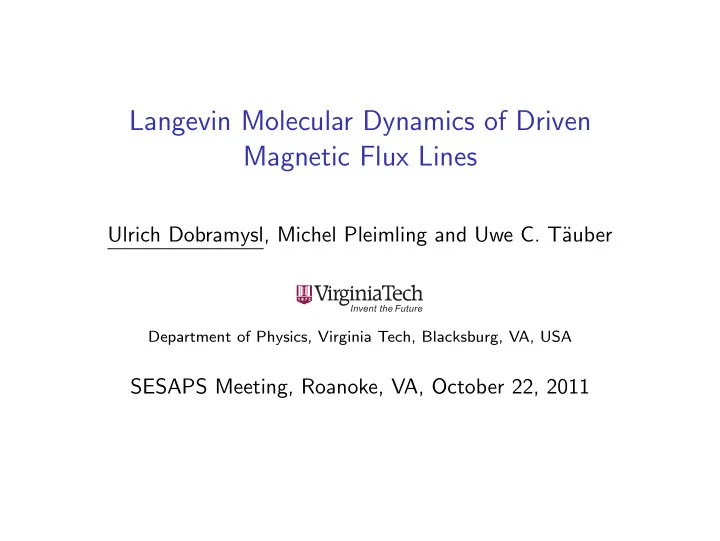

Langevin Molecular Dynamics of Driven Magnetic Flux Lines Ulrich Dobramysl, Michel Pleimling and Uwe C. T¨ auber Department of Physics, Virginia Tech, Blacksburg, VA, USA SESAPS Meeting, Roanoke, VA, October 22, 2011
Motivation ◮ Type II superconductors exhibit a second order phase transition from superconducting to normal state ◮ Magnetic flux penetrates above critical field H c 1 through vortex lines - each one carries a flux quantum ◮ Vortex lines movement generates dissipation ◮ Pinning by (artificially introduced) defect sites - optimization ◮ Complex and rich system that is accessible in experiments ◮ High T C SC - interesting for technology and applications
Elastic Line Model After coarse graining: Vortex lines are interacting elastic lines † � L N N 2 � � ǫ 1 d � r + 1 � � � � F el = V I ( | � r ij | ) + V D ( � r j ) dz � � 2 dz 2 � � 0 j =1 i � = j ◮ Elastic energy ǫ 1 (stiffness) ◮ Line interaction energy V I ( | � r ij | ) ∝ K 0 ( | � r ij | ) ◮ Defects potential V D ( � r ) due to pin sites ◮ This work: only random point defects Discretize lines into connected particles → simulations † D.R. Nelson and VM Vinokur PRB 48 13060 (1993), T. Klongcheongsan, TJ Bullard, and UC T¨ auber, Supercond Sci Tech 23 025023 (2010)
Visualization LMD simulation of interacting vortex lines in clean system → form hexagonal lattice t = 0
Methods Monte Carlo Find steady state by performing a biased random walk on the energy landscape ◮ Problem: external drive enters energy - not well defined for relaxation into non-equilibrium steady-state Langevin Molecular Dynamics Algorithm Solve the system of coupled Langevin equations r i = − ζ ˙ ¨ r i + � 2 ζ k B T � � � � F ( { � r j } ) + R ( t ) ◮ Additional random force term � η describing fast degrees of freedom - temperature bath ◮ Gaussian white noise � R i ( t ) R j ( t ′ ) � = δ ij δ ( t − t ′ ) ◮ Problem: also not well defined for non-equilibrium (driven) systems
Time regimes Transient regime Steady state ◮ Dependent on inital ◮ Time translation invariance conditions recovered ◮ Dynamical scaling - aging ◮ No dependence on initial conditions ◮ Time translation invariance ◮ All quantities stationary in broken thermodynamic limit ◮ Need two-time quantities to characterize
Driven system results 1.00 10 16 lines 16 lines Normalized velocity v/v 0 32 lines 32 lines 8 Gyration radius r g 64 lines 64 lines 0.75 LMD LMD MC MC 6 0.50 4 0.25 2 0.00 0.4 0.5 0.6 0.7 0.8 0.9 1.0 1.1 0.4 0.5 0.6 0.7 0.8 0.9 1.0 1.1 Driving force F d Driving force F d ◮ 16, 32 or 64 initially straight lines placed at random positions ◮ 34200 randomly distributed point defects ◮ Driven system, allowed to relax into steady state ◮ Agreement between MC and LMD good
Two-time height-height autocorrelation LMD yields similar results as previously performed MC simulations † No defect sites Disordered system 10 0 1.1 4 8 16 32 64 10 -1 1.0 C ( t,s ) 0.9 10 -2 C ( t,s ) /C ( s,s ) 0.8 10 -3 10 -1 10 0 10 1 10 2 10 3 10 4 t − s 0.7 5.5 ln( s − 0 . 5 C ( t,s )) 128 256 512 1024 0.6 6.0 0.5 6.5 0.4 7.0 0.3 0.0 0.5 1.0 1.5 2.0 10 -1 10 0 10 1 10 2 10 3 10 4 ln( t/s ) t − s ◮ Dynamical scaling - aging ◮ Disorder leads to glass-like exponent ≈ 0 . 5 relaxation † M. Pleimling and U.C. T¨ auber, arXiv :1106.1130 (2011)
Summary Conclusion ◮ Complex out-of-equilibrium system ◮ Important to understand vortex dynamics to optimize technological applications ◮ Both methods yield comparable results - complementary to each other ◮ LMD is much more efficient Outlook ◮ Aging regime – universality/scaling ◮ Correlated defects ◮ Thin films ◮ Relaxation of driven systems
Thank you for your attention! References ◮ D.R. Nelson and VM Vinokur PRB 48 13060 (1993) ◮ T. Klongcheongsan, TJ Bullard, and UC T¨ auber, Supercond Sci Tech 23 025023 (2010) ◮ M. Pleimling and U.C. T¨ auber, arXiv :1106.1130 (2011) This research was funded by the Department of Energy, grant number BES DE-FG02-09ER46613.
Recommend
More recommend